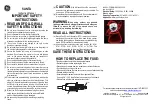
2 – Controls And Indicators
TASCAM FW-1884 Owner’s Manual
13
14. REC key
– In COMPUTER Control mode, this
is a modifier key. When pressed and held, it modifies
the behavior of other selected keys. Its behavior is
entirely dependent on the host application support.
Typically, holding the
REC
key and pressing a channel
SEL
key will arm the selected DAW channel(s) for
recording. Refer to the Application Notes for your soft-
ware for details.
In MIDI CTL and MON MIX modes, this key is inac-
tive and sends no data.
15. EQ Controls
-
In COMPUTER Control
mode, the EQ functions are normally mapped to the
corresponding parameters on the host application soft-
ware. Refer to the Application Notes for your software
for details.
In MON MIX mode, the EQ controls have no func-
tion.
In MIDI CTL mode, the four EQ band keys send out
specific MIDI messages, while the three rotary encod-
ers send out specific continuous controller commands.
The following descriptions apply in COMPUTER
control mode only:
FREQUENCY
–
Normally mapped to the frequency
control of the selected band on the host application’s
EQ section.
Q (Bandwidth)
–
Normally mapped to the Q
(bandwidth) control of the selected band on the host
application’s EQ section.
GAIN
- Normally mapped to the Gain control of the
selected band on the host application’s EQ section.
LOW key
–
Normally selects the Low band of the
host application’s EQ section.
LOW MID key
–
Normally selects the Low Mid
band of the host application’s EQ section.
HIGH MID key
–
Normally selects the High Mid
band of the host application’s EQ section.
HIGH key
–
Normally selects the High band of the
host application’s EQ section.
16. PFL key
–
In COMPUTER Control mode, this
key has no function. Solo monitoring of tracks from
the host audio application is handled by the host appli-
cation, and soloed tracks appear as outputs from the
host application.
In MON MIX mode, this key toggles the state of the
Solo function from PFL (Pre-Fader Listen) to Solo-In-
Place. Refer to section 4.3, “Monitor Mix Mode –
(General Notes)” for further details.
In MIDI CTL mode, this key has no effect.
17. Solo level control
–
This is an analog level
control for the output level of the Solo buss. It func-
tions independently of Control mode selection, and
only affects the level of the Monitor Mix channels
when soloed in PFL mode.
18. Stereo LED level meters
– The twelve-seg-
ment stereo LED meters display the level of the moni-
tor buss stereo output, before the Monitor Level
output. The signal are metered before the Monitor
Level control, so its position will not affect the level at
the LEDs The meters can monitor Inputs only, DAW
channels only, or both sources simultaneously. Three
metering modes – Instantaneous, Peak Decay or Peak
Hold – are available. For more information on meter-
ing functions, refer to section 3.7, “Monitoring and
Metering Modes”.
19. Monitor level control
–
This is an analog
level control for the output level of the Monitor buss. It
can affect all eight analog outputs, or only analog out-
puts 1 and 2, depending on the settings selected in the
FW-1884 Control Panel. For more information refer to
section 5.1, “Control Panel”. Its function is the same
regardless of the control mode selected.
20. Headphone level control
– This is an ana-
log level control for the level of the Headphone output.
Its function is the same regardless of the control mode
selected.
21. Clock input LEDs
–
These LEDs show the
current status of the digital clock master.
•
FireWire –
FireWire
(indicates valid FireWire
connection to the host computer)
•
CLOCK –
Internal Crystal Clock
•
ADAT –
ADAT Lightpipe Input
•
D IN –
S/PDIF digital input
22. Surface Mode Selection keys
-
These
keys function globally to select the Control Surface
Mode. For more information on the FW-1884’s vari-
ous Control modes, please refer to section 3.1, “Con-
trol Surface Modes”, and to the Application notes for
your software.













































